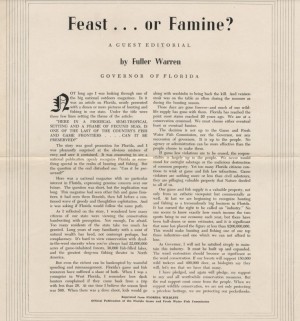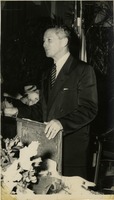Read other posts in this series and learn more about the focus of the students in Dr. Graban’s Discourse on Sustainability class which Special Collections & Archives hosted this past spring.
Past, Present and Future: A conservation analysis By Gian Caban
Having been intrigued by the concept of supply and demand in contemporary society, and with an opportunity to visit the Florida State University Special Collections & Archives, I was able to discover two different perspectives on the same concept. I explored two documents: a guest editorial entitled “Feast … or Famine” by Fuller Warren, and a conservation speech given in 1967 by former Governor Thomas LeRoy Collins. While both discussed the surplus of demand against a deficit of supply, each presented a different solution to this imbalance, according to their different attitudes towards nature. One addressed the problem as if nature were a finite resource that needed protection, while the other addressed the problem as if nature were an entity unto itself.

Fuller Warren wrote Paper “Feast.. or Famine?” while serving as Florida’s Governor. In this editorial, he discusses how times have changed and how the hunting practices of the past are no longer sustainable for the future of the state. Arguing that the state’s “game and fish supply is a valuable property” highlights Warren’s potential view of nature as a resource. As a result, he would argue that Floridians should conserve their resources for the objective benefit of Florida’s economy. Thus, one sustainable solution to the supply and demand imbalance would occur in the creation of rules and regulations as well as proper enforcement of those rules.

LeRoy Collins delivered his speech after his gubernatorial term, though he also discusses how Florida’s technological advancements and population growth have created demands on its natural resources. As a result, he notes an increase in wants and needs, and a deficit of supplies to provide for the general public, leading to a decrease in quality of services as well as threats to the “beautiful rivers and streams [that] have been polluted beyond recognition.” While Collins views nature as a resource to some extent, the rhetoric he uses indicates that he may view nature through a Romantic lens, arguing for its beauty as something to preserve for future generations to create connections to it.
These documents reflect contrasting ways of looking at the issue of supply and demand, each highlighting a fundamental issue with how one’s way of viewing and tackling conservation impacts the State, yet there is a similar strain running across them. While Warren proposed laws and regulations when there was no such law enforcement yet available, Collins urged residents to look to the past to make choices for the future. Both men outlined the fundamental idea that it is up to the Floridian’s way of thinking about an issue and to their personal accountability that would lead to environmental and societal change. These arguments would ideally create not transactional compromises, but rather transformations of the state’s conservation policies systems, by encouraging Floridians to both utilize nature’s resources and allow nature to effectively sustain itself.
Works Cited
Florida State Conservation Department, 1949, Box: 40, Folder: 09. Fuller Warren Papers, MSS 0-257. FSU Special Collections & Archives. http://purl.flvc.org/fsu/fd/FSU_MSS_0257_B040_F009
Florida Historical Society, Key West- Conservation Speech, May 6, 1967,
Box: 46, Folder: 12. Thomas LeRoy Collins Papers, MSS 1991-012. FSU Special Collections & Archives. http://purl.flvc.org/fsu/fd/FSU_MSS_1991012_B046_F012
LeRoy Collins and the Expansion of Florida by Hailie Tucker
LeRoy Collins was the 33rd governor of Florida and had a large impact on the expansion of Florida and the environmental impacts related to the population increase. His stances and perspectives had some key differences at two separate points in his career during 1960 and 1967. Through the FSU archives I was able to read some of his speeches, that being his remarks at the dedication of Key Largo Coral Reef preserve in 1960 and his remarks at the annual meeting of the Florida historical society in 1967.

On December 10 of 1960, he was proud of the first underwater park in Florida which simultaneously was the first in the nation. He wanted to grow the tourism aspect of Florida by renovating the land with highways, and the development of facilities to be used by tourists and residences. He was clear though, that this development should not be at the cost of nature. Later on, he realized in hindsight that the cost of development was the loss of nature within the regions developed as the rural regions turned increasingly urban. At the time he spoke of over 5 million residents and 11 million travelers visiting within the year before. He believed that nature could be preserved with the tourism increases and referenced the environmentally important figure that is John Pennekamp.
Florida’s population grew at rapid rates, especially in the 1950s as the population increased by 8% in just 1956 (Perry et al.). The rapid population growth caused the need for development to support the citizens, as such affecting the society’s economic stability as well as the nature cleared to make room for human civilization.
In contrast to his speech in 1960, Collins noticed the cost on nature that the expansion had taken. On May 6 of 1967, he remarked about the writings of Professor C. Van. Woodward and the separated mentality of southerners. He connects how the world has evolved through history to the current point, and how it will evolve from the current point to the future. This is meant to question whether the future is bound to lead to a positive or negative outcome. He believes that each choice made by the individual is what determines what will become history. The projected population increase was 30% by 1970. Florida’s population has been increasing since 1947. He presents the question of whether Florida can support the rising number of residents. Based upon the increasing citrus industry, general agriculture, and tourism, Florida could likely support the population increase economically. However, the geometric increase of the resources needed to support the growing population, will lead the citizens to lack in many of their human needs. The environment has reached its threshold from polluted rivers to the risk of the Everglades drying up. He wants to motivate the people to learn from the mistakes of the past to avoid such pitfalls in the future.
Works Cited
Dedication of Key Largo Coral Reef Preserve, December 10, 1960, Box: 9, Folder: 11. Thomas LeRoy Collins Papers, MSS 1991-012. FSU Special Collections & Archives
Florida Historical Society, Key West – Conservation Speech, May 6, 1967, Box: 46, Folder: 12. Thomas LeRoy Collins Papers, MSS 1991-012. FSU Special Collections & Archives.
Perry, Marc, et al. “Florida Fastest-Growing State for First Time Since 1957.” Census Bureau,
22 December 2022, https://www.census.gov/library/stories/2022/12/florida-fastest-growing-state.html. Accessed 15 April 2024.